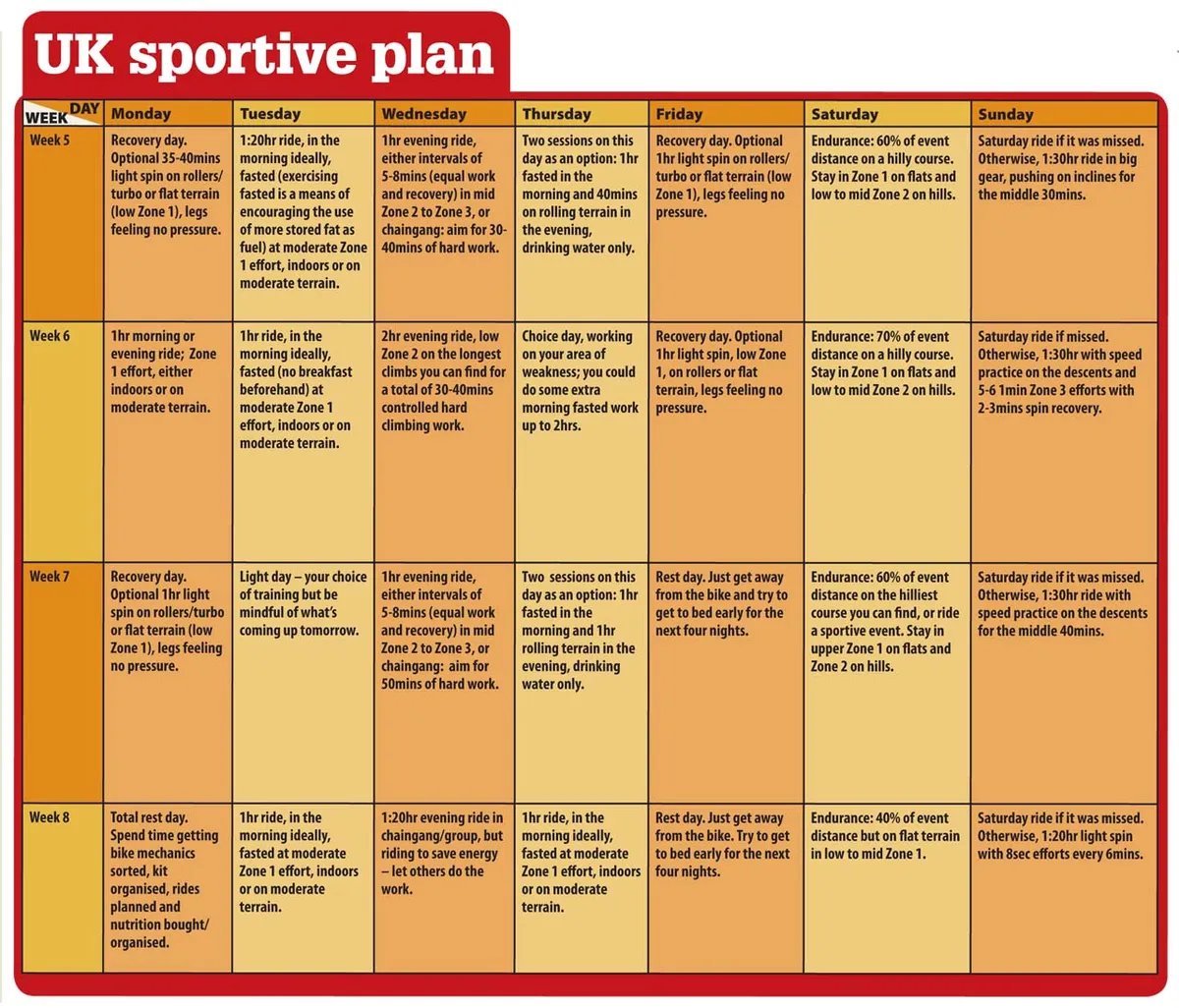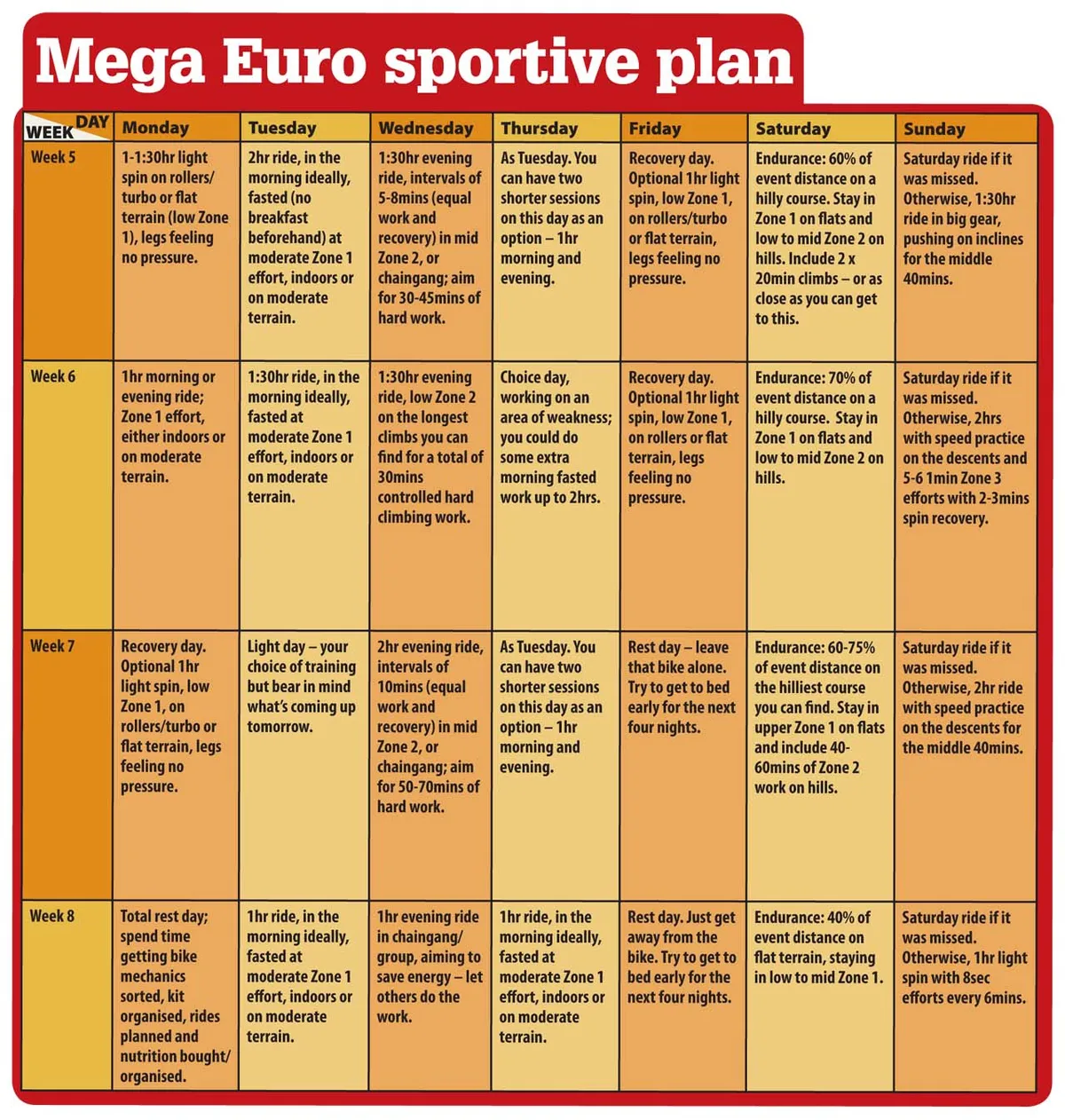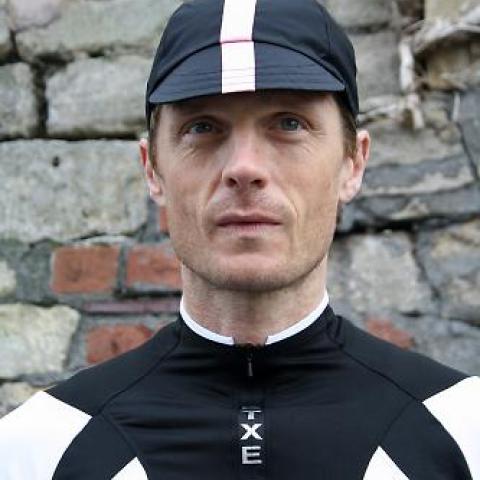Hopefully you’ve gotten in some quality training miles over the past few weeks and you’re starting to build up your sportive-specific fitness. Next we look at the programmes for weeks five to eight of our three-month regime – a critical period before the final four weeks of training that take you up to the Cycling Plus Sportive in association with the Geoff Thomas Foundation at BikeRadar Live.
If your sportive isn’t until later on in the summer you can still complete this training schedule, then adapt it so that it’s 10 percent more demanding and run through it again, continuing to focus on your areas of weakness until four weeks before your event. Only then should you move on to the final four-week programme to get you at your start line ready to rock.
Avoiding injury
When training for a sportive, you could well step up the amount of riding you do, resulting in extra stresses and strains on your body. You might also be tempted to ignore niggles because you want to stick with the programme. Don't!
Riding through the pain is a great way to turn a minor problem into a major one, and with ligaments and tendons in particular you dont want to take that chance because they can take ages to heal.
If you get injured, take it seriously. Have time off the bike and rest or do some cross-training and, if it's a biomechanical problem, have your ride position looked at by an expert. If necessary, visit a health care professional and get it checked out. Whatever you do, don't ignore a potential injury when it is in the niggle stage.
Also beware of overtraining, which is a reduction in your ability to exercise because you're not getting the rest and recovery that you need. There are many tell-tale signs of overtraining, including:
- Reduced performance
- Lack of enthusiasm for riding
- Susceptibility to injuries and infections
- Sore muscles
- Changes in your sleep patterns
- Decreased heart rate during exercise
- Irritability and lack of clear-headed decision-making
- Difficulty holding a usually-sustainable heart rate
- Lower than normal power at a given heart rate
If you think this might be you, measure your resting heart rate when you wake up in the morning and if it's 10 percent higher than usual, take this as a warning sign that you're over-reaching, kick back and have a day off exercise. Don't plough on regardless – you won't improve your fitness and you could end up in trouble.
It's a fine line between training to the max and overdoing it, and only you can really tell when it's time to back off – everyone has different limits. But the sensible advice is: if in doubt, leave it out.
Handling the hills
Sportives come in many different flavours but the one constant is that they're all hilly – some of them mountainous – so you need to be prepared for tackling the climbs. Our training programmes will take care of the fitness side of things, but you need to work on your technique in training too, both going up and coming down the other side.
- Alter your mindset: We're not going to get all psychological here, but if you think hills are the work of Satan and your main thought when you're climbing is, 'I wish this would end', you're not going to get far. You find hills difficult? So does everyone else, but you have to deal with them. See them as a challenge and you can learn to love the climbs. Seek them out in training and you can start making some real progress.
- Know your sustainable climbing pace: Whether you use a heartrate monitor, a power meter, or just your own experience, find out in training the intensity you can sustain on long climbs without going into overdrive. Halfway through a sportive is a bad time to discover your limits. If you do notice your heartrate climbing unexpectedly or your power starts to drop off, it's time to up your feeding rate.
- Experiment with cadence: There's no set speed at which you should be turning your cranks. Think back a few years to Lance Armstrong's quick spinning compared to Jan Ullrich's steady stomping, yet both were excellent climbers. Use your training rides not only to find the cadence that gets you to the top quickest, but also the cadence that gets you there feeling freshest – it's likely to be over 75rpm and perhaps nearer 100. Give yourself time to adjust to a new cadence – it might feel quite unnatural at first.
- Practise seated climbing: If you're going to have a good sportive, you need to be comfortable climbing while both seated and standing. So even if the hills around your way are short and you can get up them quickest with out-of-the-saddle blasts, practise getting the revs in from the saddle. You can get more power when you stand, but it also takes more effort… and you need to think about conserving energy on your sportive. It's good to break up climbs with occasional out-of-the-saddle efforts but do the bulk of long hills seated.
- Learn to read the climbs: Don't wait until your legs start screaming before you change gear. If you can see the gradient's about to change, shift early and maintain your cadence, or get out of the saddle. You don't want to overload your muscles or build up lactate.
- Relax your upper body: This won't just make you more comfortable, it will enable you to get more oxygen in your lungs and, ultimately, ride faster.
Training plans

(Click on the plans to bring up larger versions)


Using our training plans
We've kept things simple by using just three different zones of training intensity in our programmes. You can make sure you're exercising at the right level either with a heart rate monitor (HRM) or by using perceived exertion – how hard you feel you're working.
If you use an HRM, our zones are based on your maximum heart rate (max HR). Subtracting your age from 220 will give you a theoretical max HR, but it can be inaccurate – sometimes wildly out.
- Zone 1: 60-80 percent max HR (60-75 percent if you are getting back to fitness or lack stamina). This is light to moderate effort; conversation is easy and you can breathe through your nose only.
- Zone 2: 80-89 percent max HR (75-85 percent if you are getting back to fitness or lack stamina). Moderate to hard effort, though it is controlled and you are not about to blow up. This is above average sportive pace: the lower end is most likely your climbing pace while you can only survive at the top end for 60-90mins.
- Zone 3: Around 90 percent max HR and above (85 percent and above when lacking fitness). Very hard; breathing is laboured and lactate makes your muscles burn. Stay out of this zone in long events; use it only for short intervals or races in the build-up to a sportive.
About BikeRadar Live
BikeRadar Live is the biggest ever mass-participation cycling event to hit the UK, and will take place on the weekend of 30–31 May 2009 at DoningtonPark in Leicestershire.
The weekend will be packed full of races and challenges, with something for everyone, whether you want to compete, watch your friends and family or just check out some of the world’s best riders.
Entry into any of the events gives you full access to the festival’s many attractions including spectacular all-weather stunt displays, invitational dirt jump and dual slalom comps, a cycling film festival, live big top entertainment and the Scott Sunset DJ Sessions. Test yourself against pro and celebrity riders in the Procycling Hot Laps, post a time in the Wattbike comp or take the kids along to the Islabikes Children's Skills School. A purpose-built bikes and accessories expo will give festival-goers the chance to ride the latest bikes from leading brands and grab show-only deals on bikes and accessories.
Events include the Cycling Plus Sportive in association with the Geoff Thomas Foundation (100km and 100 mile), Whyte Night night-time enduros (12hr and 4hr), MBUK Eliminator dual-slalom and the Devil Takes the Hindmost circuit race. Click here to sign up.
BikeRadar Live’s world-class facilities include on-site camping with a kids and family area, secure bike lock-up, showers, bike wash, workshop, picnic area, medical centre, viewing stands and food and drink market.
BikeRadar Live is brought to you by Future, the makers of Mountain Biking UK, Cycling Plus, BikeRadar.com, What Mountain Bike, Cyclingnews.com and Procycling. For more details, go to the BikeRadar Live website.

